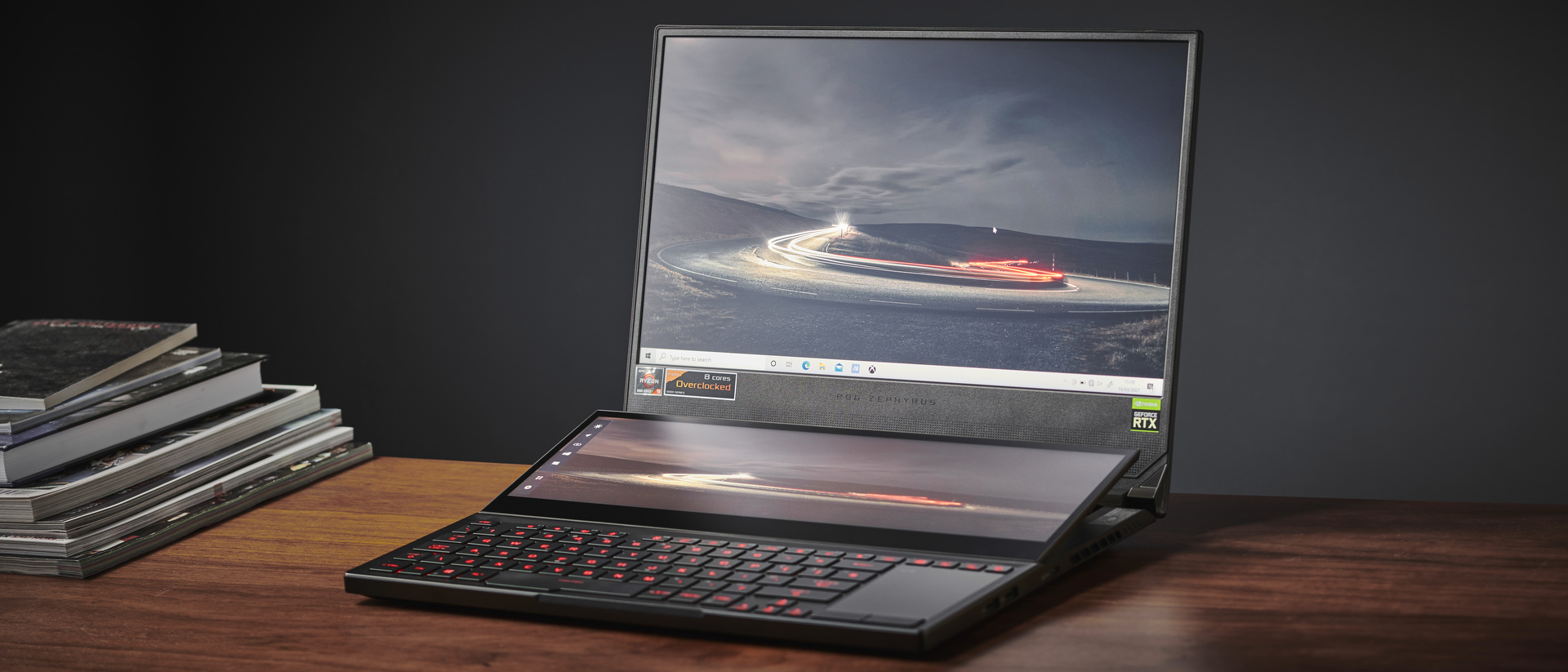TechRadar Verdict
Two screens and super-powered components make the Asus ROG Zephyrus Duo 15 SE GX551 a potent laptop, but it has issues, including an incredibly heavy and bulky design and an awkward keyboard. It's very, very expensive as well.
Pros
- +
Incredible CPU/GPU combo
- +
Highly pleasing looks
- +
Superior main screen
Cons
- -
Massively heavy
- -
Cramped, awkward keyboard
- -
Costs and arm, a leg, and your first born
Why you can trust TechRadar
Two-minute review
There are levels of ludicrous excess, and there are laptops like the Asus ROG Zephyrus Duo 15 SE GX551 - a machine so committed to baking the ultimate gaming cake that it burns itself a little.
And not just in the way it gets extremely hot when pushed; it's absolutely beautiful, and Asus' second screen is a brilliant thing, but its presence crushes the keyboard and trackpad in a way which isn't natural for the muscle memory of most laptop users, and it is of questionable usefulness for, we'd say, the majority of gamers.
Streamers may well love it, however. Dropping Discord on an ultra-wide second screen may be useful if you're getting hot and heavy with some multiplayer gaming on the main display. There's also a small list of games, like Dying Light, which actively support it, popping their map or inventory where you can always see it. It has productivity uses, though they're probably best left for the non-gaming spin on this tech which can be found in the Zenbook Duo line - particularly given the price here. You'll get a stronger battery (this does OK for desktop performance at around five hours, but struggles if you're blasting it hard with games) and a less angry bank manager.
The Asus ROG Zephyrus Duo 15 SE GX551 is so expensive, even in its lower-tier setup, that it puts itself into a niche most won't be able to think of visiting. This, and and the design hole Asus has dug for itself - one we're not sure this kind of laptop will ever be able to dig itself out of - mean we can't wholeheartedly recommend the Asus ROG Zephyrus Duo 15 SE GX551, but it deserves serious commendation for its power. This has more sheer ape strength than basically anything else on the market, packed into a case far smaller than it has any right to be.
And so, to sum up: this is a brilliant, brilliant machine. It is an engineering marvel, a significant over-performing upgrade on its predecessor thanks to the leap to AMD and Nvidia RTX 30-series graphics, making it a true shining light of the high-end laptop market. We would love to own one, and you probably would too, but you really shouldn't even think about buying it unless there is money literally burning a hole in your pocket - and we're not sure Asus accepts charred notes. Opt for a similarly-priced traditional laptop, and we'd wager you'll have a more comfortable time.
Here is the Asus ROG Zephyrus Duo 15 SE GX551 configuration sent to TechRadar for review:
CPU: 3.3GHz AMD Ryzen 9 5900HX (octa-core, 16 thread, 16MB cache, 4.60GHz boost)
Graphics: Nvidia GeForce RTX 3080 (16GB GDDR6), AMD Radeon RX Vega 8
RAM: 32GB DDR4 (1,600MHz)
Screen: 15.6-inch IPS @ 120Hz (3840 x 2160), 14.1" 60Hz touch screen 3840 x 1100 secondary display
Storage: 2TB M.2 NVMe (2x 1TB, RAID 0)
Ports: 1x 3.5mm Combo Audio Jack, 1x HDMI 2.0b, 3x USB 3.2 Gen 2 Type-A, 1x USB 3.2 Gen 2 Type-C (supports DisplayPort / power delivery), 1x RJ45 LAN port, 1x card reader (microSD)
Connectivity: Wi-Fi 6 (802.11ax), Bluetooth 5.1 (Dual band)
Camera: None
Weight: 5.47 pounds (2.48 kg)
Size: 14.17 x 10.55 x 0.82 inches (36 x 26.8 x 2.09 cm; W x D x H)
Price and availability
The Asus ROG Zephyrus Duo 15 SE GX551 is on the rarer end of laptops - it's not the thing you'll see churned out in massive numbers, but Asus seems to have secured a good supply chain in most regions, so you'll be able to snag one if you shop around. Looking at stockists, it seems as if you won't be paying much less than the MSRP - and, indeed, you may need to shell out a small premium.
The lower-spec version comes in at $2,999.99 (£2,499, AU$4,099), which bags you an RTX 3070 (8GB GDDR6), a 300Hz IPS FHD screen, 16GB RAM soldered on, 16GB slotted and 1TB M.2 storage.
The version we're reviewing here is the heavyweight edition of the Asus ROG Zephyrus Duo 15 SE GX551, the full-fat $3,699.99 (£3,499, AU$5,599) spin which includes an RTX 3080 (16GB GDDR6), 120Hz IPS 4K screen, 16GB RAM soldered on, 16GB slotted, and a combined 2TB M.2 storage.
Let us be very clear. Whichever model you go for, this is an expensive machine built for those with money to throw around. It is probably not for the likes of us.
It is an investment in a gimmick, an investment in cutting-edge power, and an investment in a status symbol. It is not, in any way, an investment the vast majority of people should be making. That sort of money is a frankly ridiculous ask - though looking at the competition, the likes of the 4K version of the Razer Blade 15 or the MSI GE66 Raider, that seems to be today's asking price for high-spec laptops. The second screen comes as a bonus, if anything. But still - this ain't cheap.
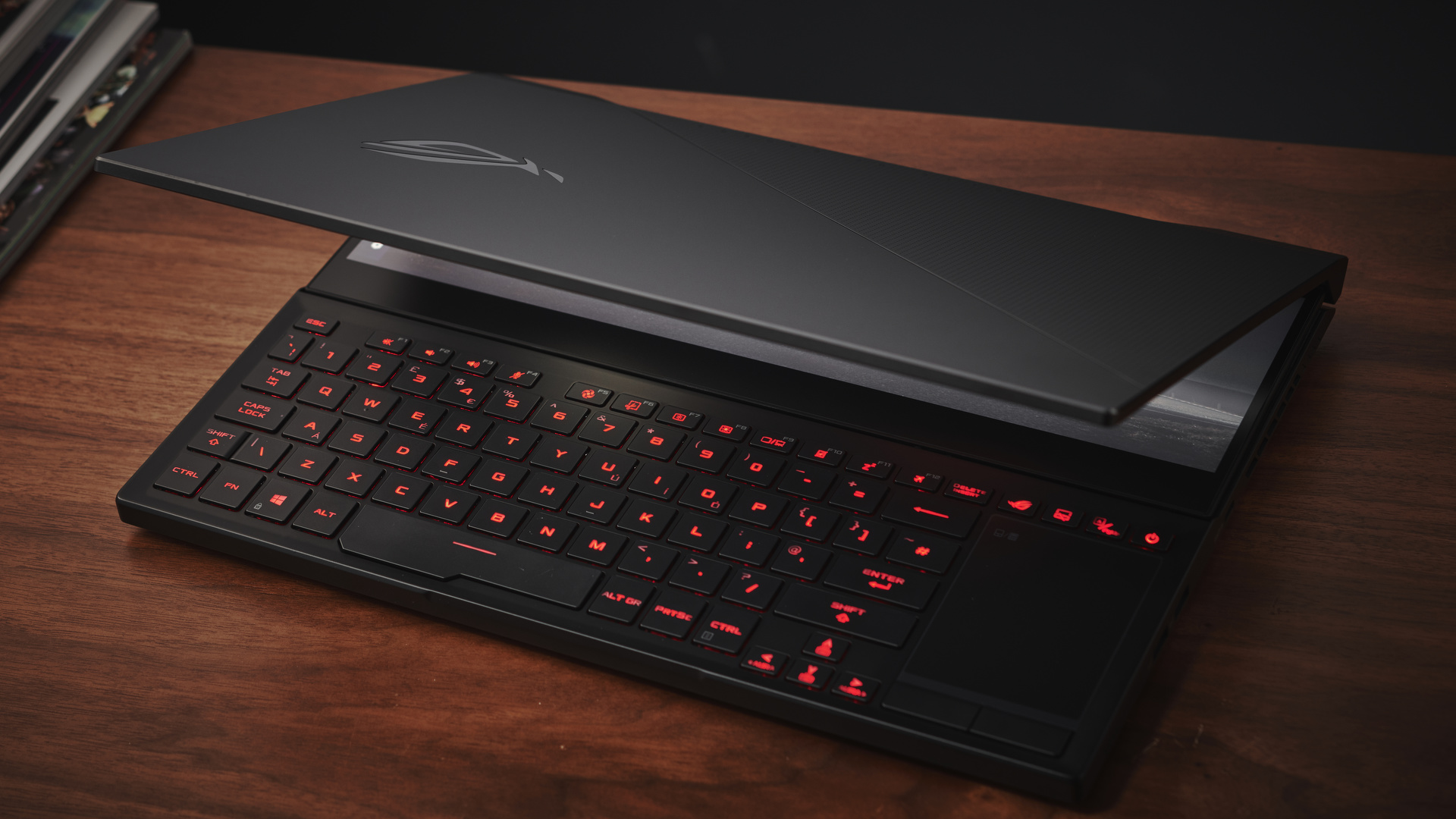
Design
This is simultaneously one of the most extra laptops ever designed and, somehow, one which shows a fair measure of restraint. It's angular in all the right ways, following the design notes that Asus has progressively leaned on for its recent gaming machines but not taking things too far; the completely unnecessary (but undeniably cool) dot matrix lid display of higher-tier ROG Zephyrus G14s is left out, for example.
The tight design does mean there are some awkward notes. There's no built in webcam, which isn't exactly upsetting given that the alternative would have been a less beautifully-bezeled display or an up-the-nose below screen cam, but it is an omission. Certain spec listings online suggest it will be bundled with a 1080p external cam, but our review unit was not.
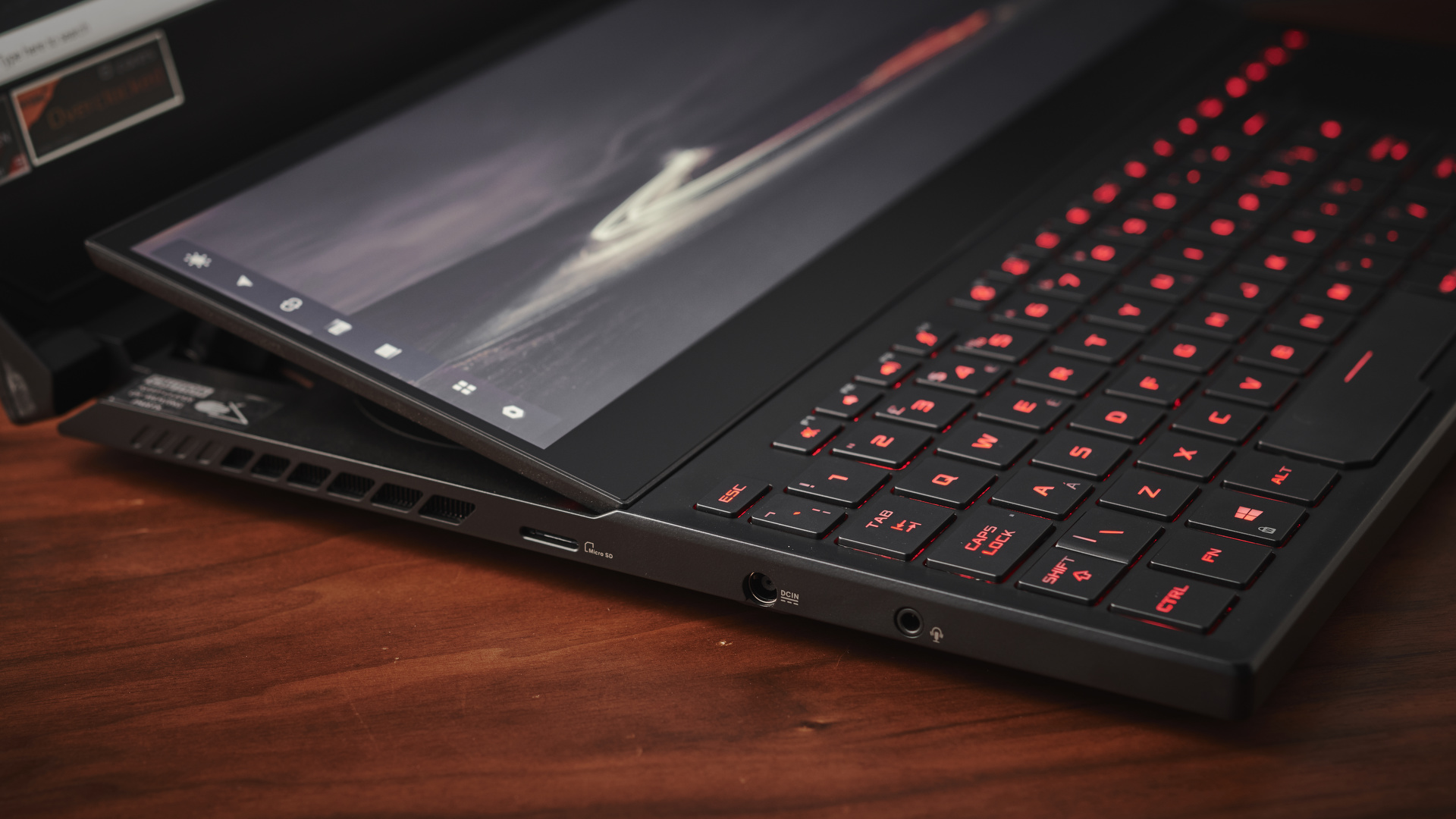
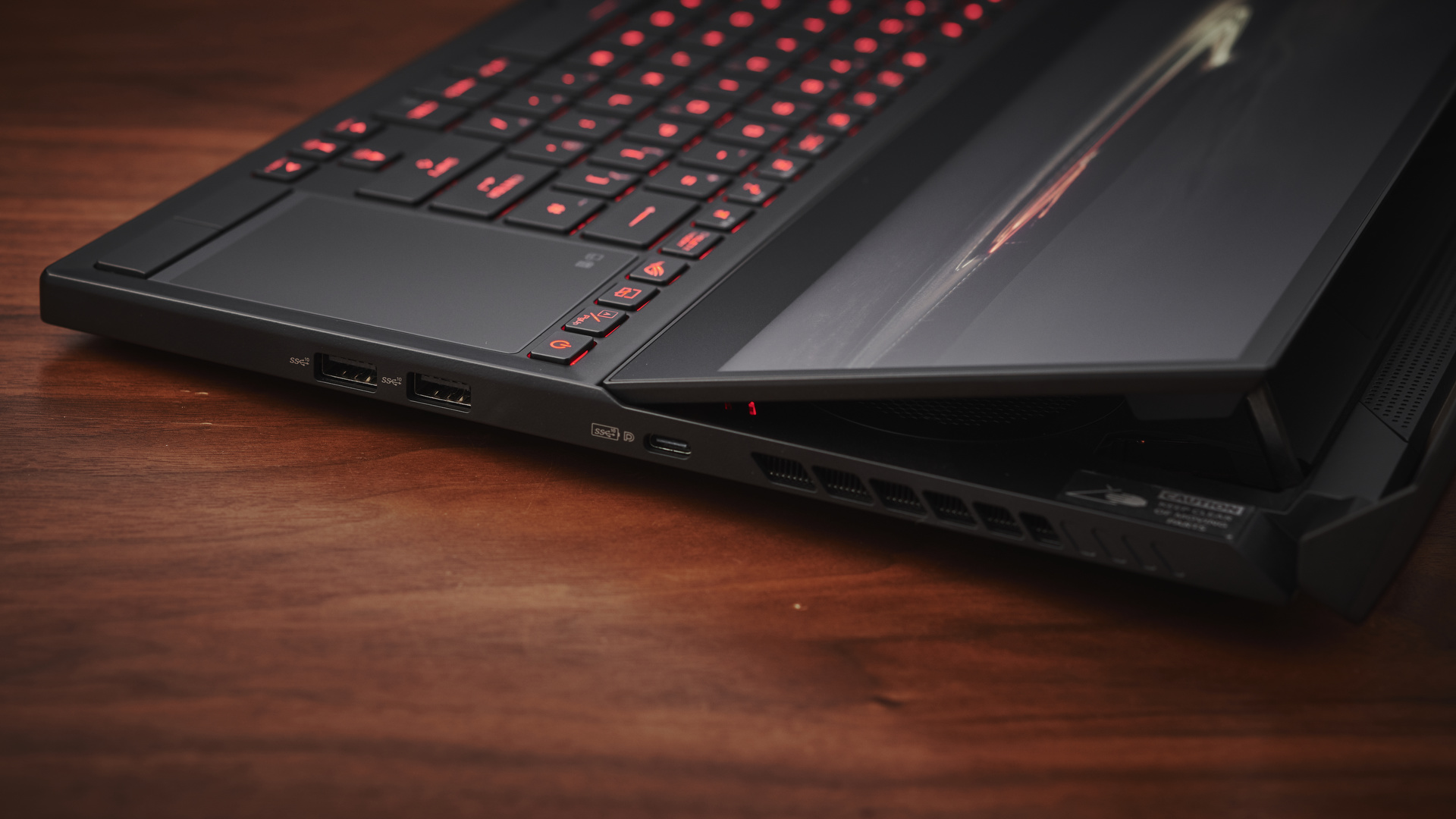
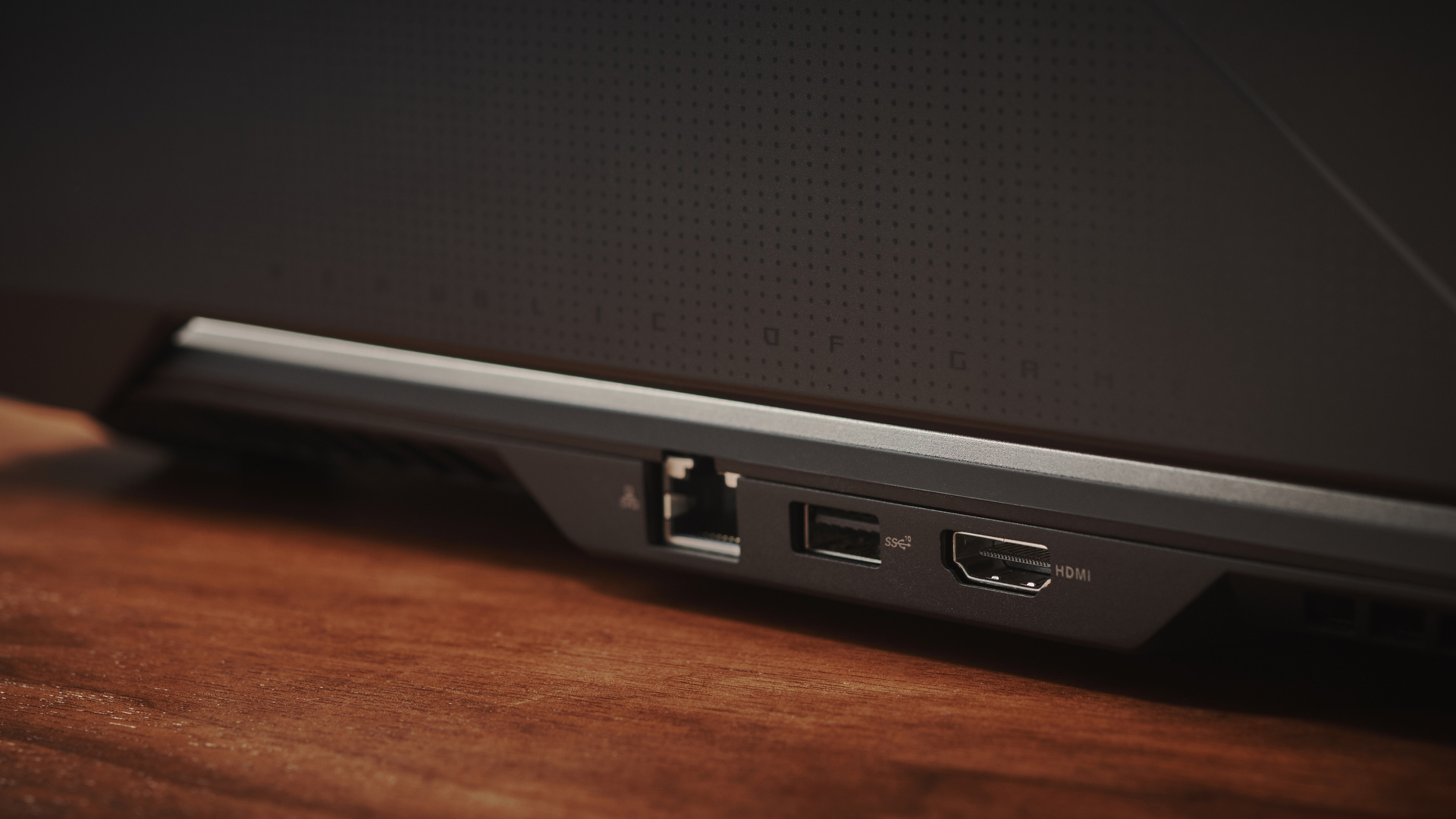
Port placement is tricky, too. The left edge houses the chunky power cable, closer to the front edge than the rear, as well as an audio jack and microSD reader - the latter a welcome addition from the previous generation.
The right houses a pair of USB 3.2 ports, and a DisplayPort- compatible Type-C port. For Ethernet, HDMI, and a third USB port, you'll need to head around the back. Nothing deal-breaking, and that's the correct collection of ports on the right edge, but it does mean desk placement could be slightly more awkward.
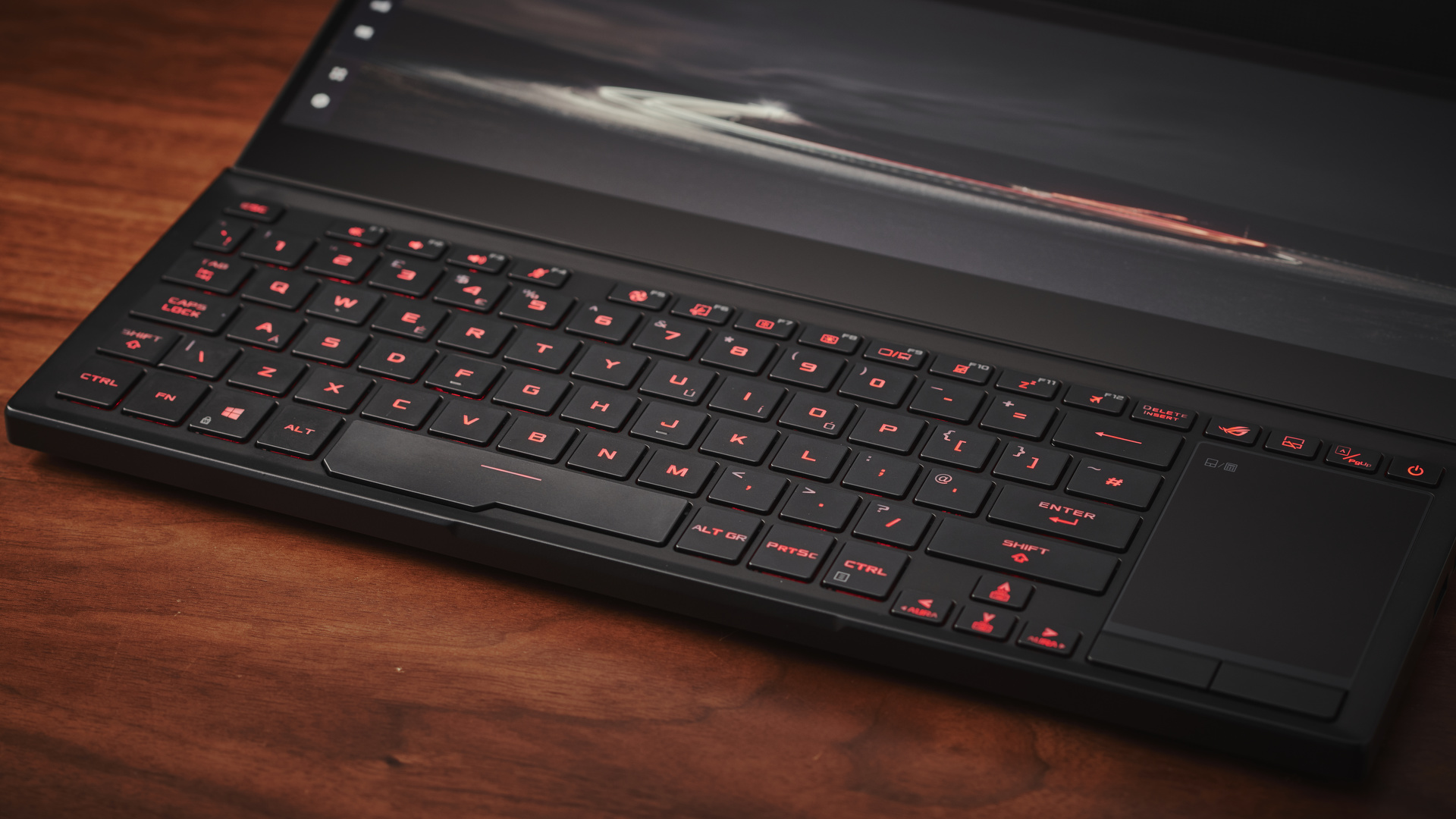
Speaking of awkward, the addition of the second screen means you get the same cramped keyboard design as others in Asus' dual-screen lines, crushed towards the front of the base with its trackpad aligned to the right.
It's packed with clever touches, like the number pad which hides beneath the trackpad and toggles with a long press of the top corner, and some delectable, restrained RGB lighting. Key travel feels great, with an impressive amount of depth. It's about as good as you could hope for - but boy is that thing difficult to actually use.
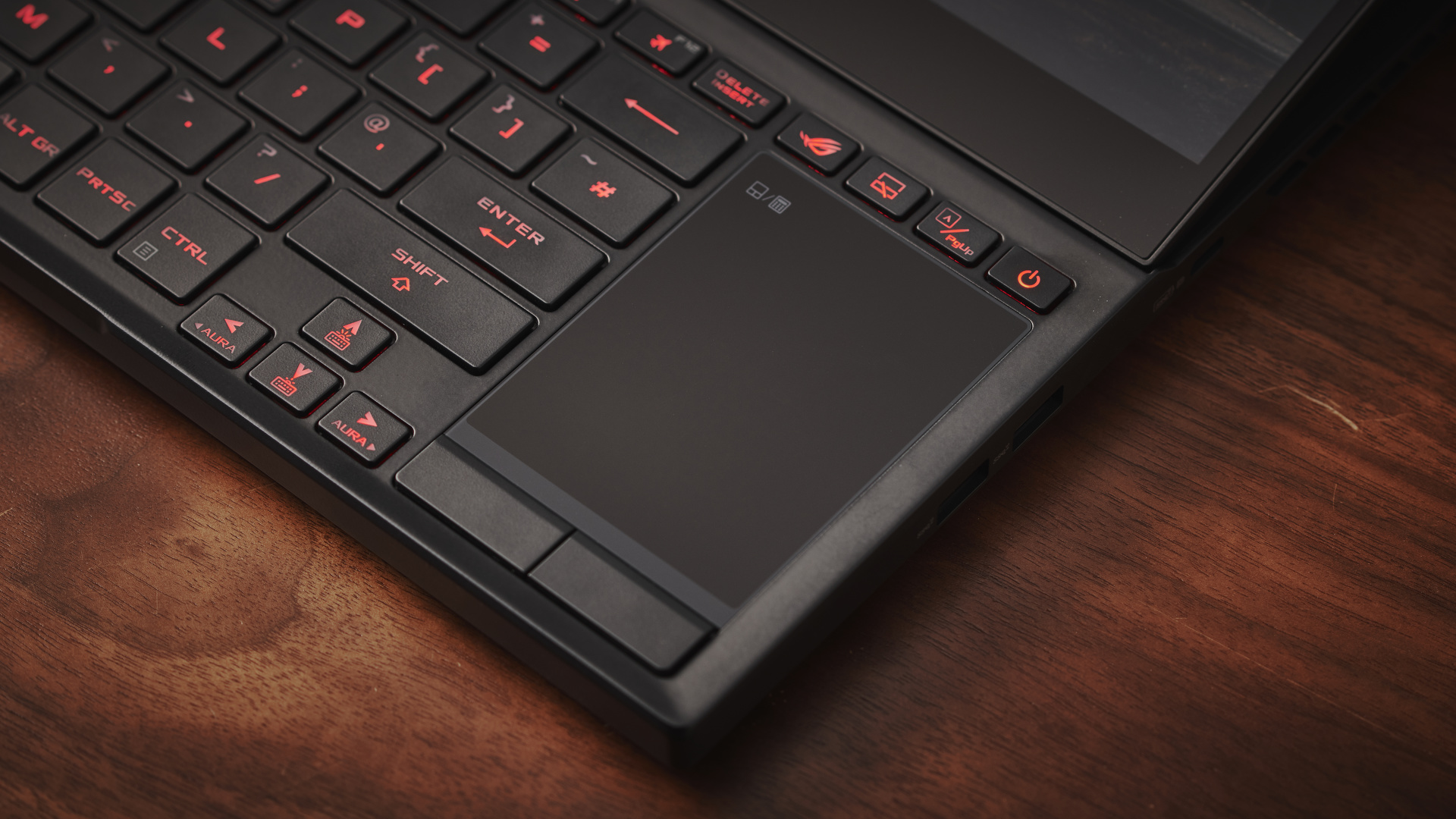
Even after a couple of weeks' work and gaming using the squeezed layout didn't feel natural. The narrow trackpad meant this tap-to-click averse reviewer consistently pressed the right arrow key rather than the left mouse button, and there's a slight lip in front of the space bar which, when fingering WASD, sits right on the first knuckle of left thumb.
Not a huge issue, particularly because Asus includes a decent wrist rest in the box, but not super comfortable either.
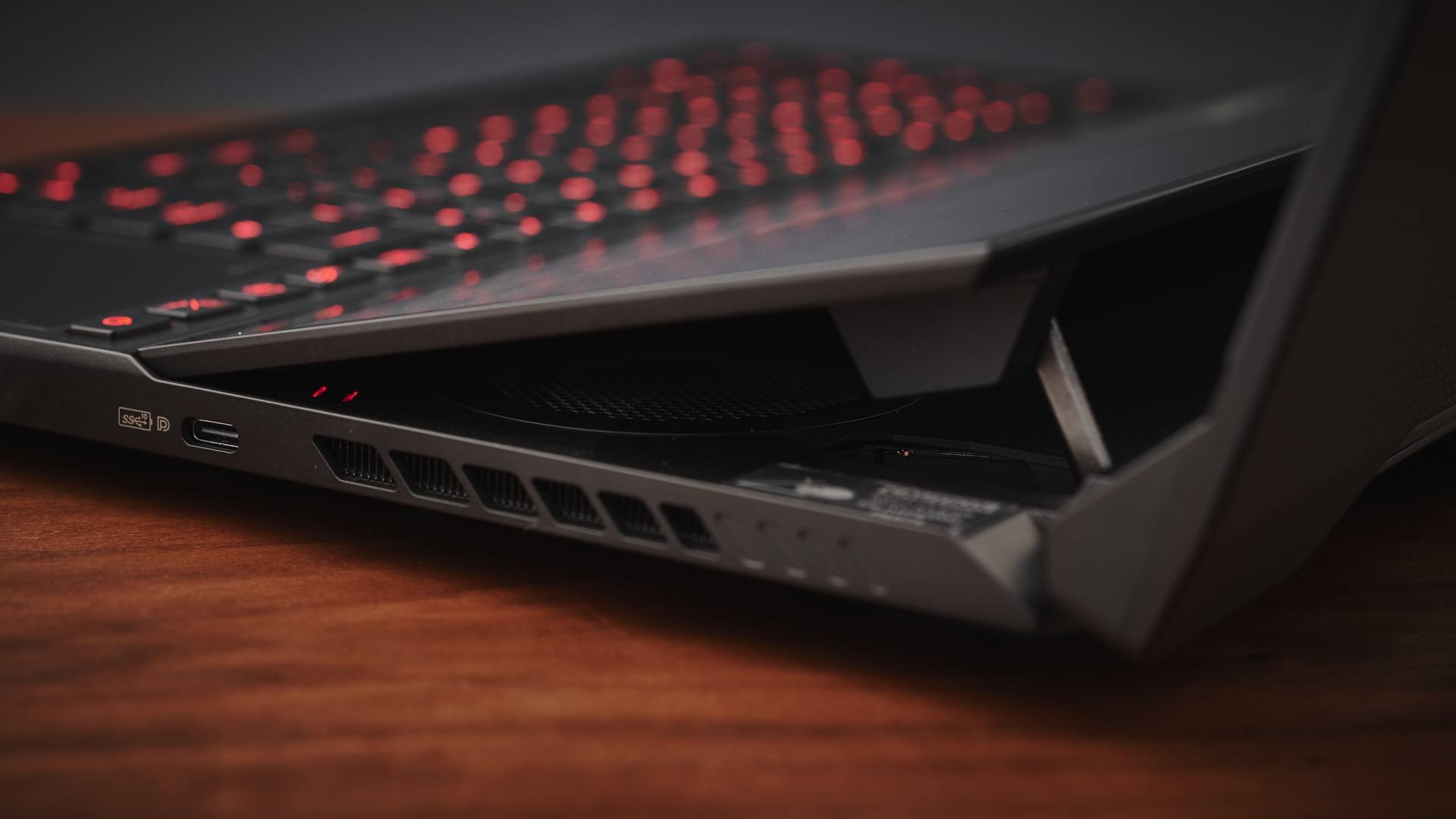
So what of that second screen? Its upward tilt is neat, compared with the flat format of the Zenbook Pro Duo UX581, and the automatic hinge is super-sturdy.
It holds up the subscreen - which Asus calls the ScreenPad - at the left and right edges, meaning there's a little flex to the second screen when pressed. This will make you nervous given the price - and we can't imagine long-term owners won't constantly be watching to make sure the mechanism has engaged when shutting the lid even years on from purchase - but its multi-touch responsiveness is slick, and Asus' software makes managing its contents fairly easy. Beneath it are large air intakes, meaning there's no way to lay it flat.
The down-firing speakers of the previous version make a reappearance here, but this time they're joined by a pair of front-firers for a Dolby Atmos-infused audio experience that, while about the volume and clarity we'd expect for a space-limited laptop sound system, does draw you in nicely.
All this tech crammed into such a small space means the Zephyrus Duo 15 SE GX551 is, to put it mildly, incredibly heavy. This thing is a dense 5.47lbs (2.48Kg) and feels every ounce of it. And it demands a lot of power, too: the charger is a massive 280W brick, weighing almost as much as the laptop itself. Stow this in a bag and you're going to know about it.
Performance
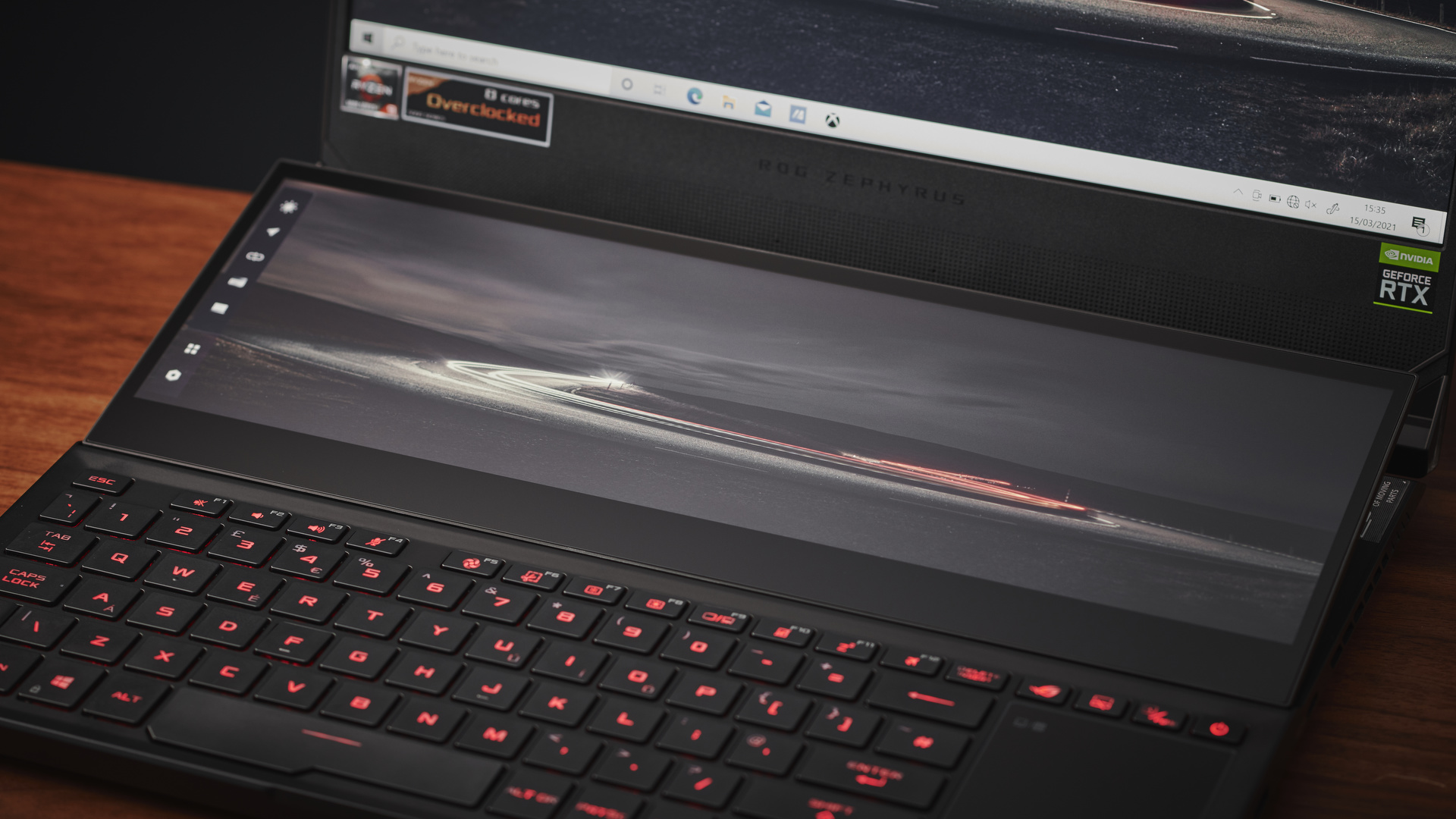
Here's how the Asus ROG Zephyrus Duo 15 SE GX551 performed in our suite of benchmark tests:
3DMark: Sky Diver: 29,674; Fire Strike: 20,591; Time Spy: 10,786
Cinebench CPU: 5,488 points
GeekBench 5: 1,442 (single-core); 8,395 (multi-core)
PCMark 10 (Home Test): 6,914 points
PCMark 10 Battery Life: 5 hours and 30 minutes
Battery Life (TechRadar movie test): 4 hours and 33 minutes
Total War: Three Kingdoms (1080p, Ultra): 85 fps; (1080p, Low): 200.7 fps
Red Dead Redemption II (1080p, Ultra): 104 fps; (1080p, Low): 121 fps; (4K, Ultra): 52 fps; (4K, low): 66 fps
It would be cheesy and cliched to suggest you look at the spec list and imagine how this might perform, but we're not afraid of a journalistic shortcut or two. This is as monstrous as its components suggest, and it performs like an absolute star.
The Asus ROG Zephyrus Duo 15 SE GX551 isn't some static feature-creep sequel. It sees Asus abandoning Intel to take advantage of AMD's latest Ryzen 5000-series mobile processor - in this case the octa-core Ryzen 9 5900HX, which can boost its 16 threads up to 4.6 GHz.
The GPU boosts from the top end of Nvidia's 20-series in the previous model to (predictably) the top end of the company's 30-series mobile cards, itself tweaked and tuned by Asus' custom overclocks. There's a massive amount of solid-state storage, and a full 32GB RAM on board. It's packed to the gills.
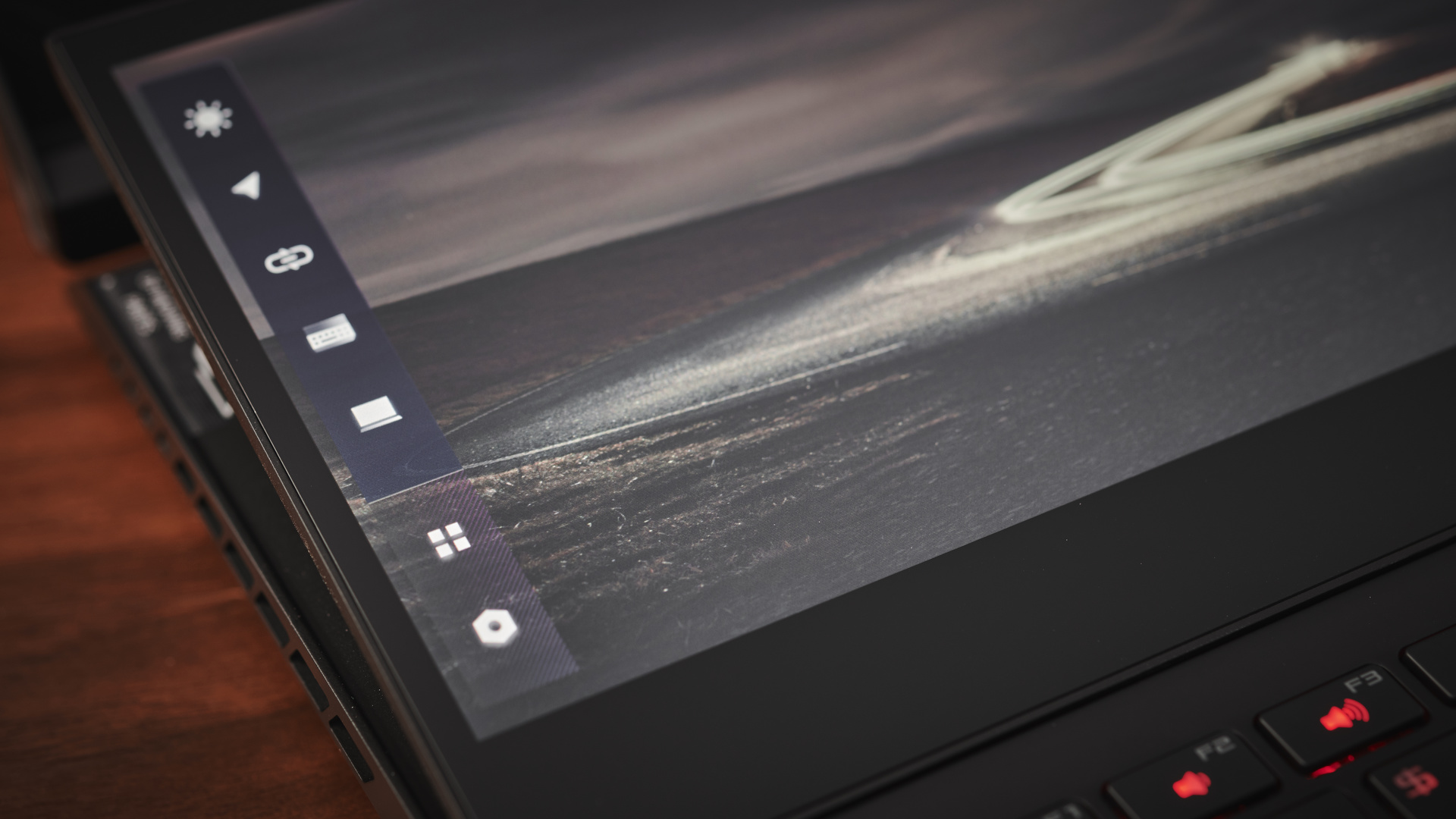
The 4K screen gets a boost from the previous generation's 60Hz to 120Hz, and looks magnificent with it; that second display is a chopped-and-sliced 4K, and it's cool, though getting the best viewing angle on it does depend on being up close and personal with the laptop. Given the awkward position of the keyboard this means typing like a T-Rex.
And so to the numbers. They're huge. A quantum leap ahead of the last generation, in a machine which proves itself to be a 4K gaming powerhouse and one with 1080p muscle for days. The GX551 trounces its competition in just about every aspect - the CPU scores in Cinebench are outstanding, the 3DMark and PCMark scores far beyond what we were expecting, and the actual gaming benchmarks a real achievement. Outside of the slightly clinical world of benchmarks, playing games on the Asus ROG Zephyrus Duo 15 SE GX551 feels great, smooth, slick, magnificent - but moving the laptop after a solid session proves that even with its large air intakes this is a machine that gets very hot.
We should point out, also, that the scores listed were taken in the Asus ROG Zephyrus Duo 15 SE GX551's Turbo mode, which overclocks both the processor and GPU. That's not cheating - it's what this machine is capable of, which is the point in benchmarks - but to be fair we also ran the benchmarks in Performance mode, the mode you'll run more often given that Turbo mode does allow the components to get slightly hotter (and the fans slightly louder) than we'd be comfortable with running on a regular basis. The results were reassuring: every single benchmark handily beat those of last year's G550 by some margin.
In 'Performance' mode Cinebench R20 topped out at a respectable 4114, 3DMark's Time Spy managed a very good 8071. PCMark dropped only slightly from its Turbo-addled score, scoring 6017, and each of the Red Dead Redemption 2 benchmarks dipped by around 5FPS - not something that was noticeable to our eyes.
Battery life
It's natural to approach a machine like this - that is, a high-end gaming laptop - and expect the battery to be some kind of half-hearted afterthought. And, well, that's not far from the mark, but this is slightly more than a token effort put there just to allow you to save your game if the power goes out.
It managed a solid five-and-a-half hours in PCMark's battery life test, and four-and-a-half while looping a movie, which is on the lower end of reasonable, and slightly more than we'd expect to be packed into these slim guts.
Naturally we gamed on the battery, and hit a pretty-much industry standard almost-two-hours of cooking the components before it gave up the ghost. This isn't a laptop that's going to get you through a long flight: it's a machine you can game on anywhere, as long as you're in sight of a power socket.
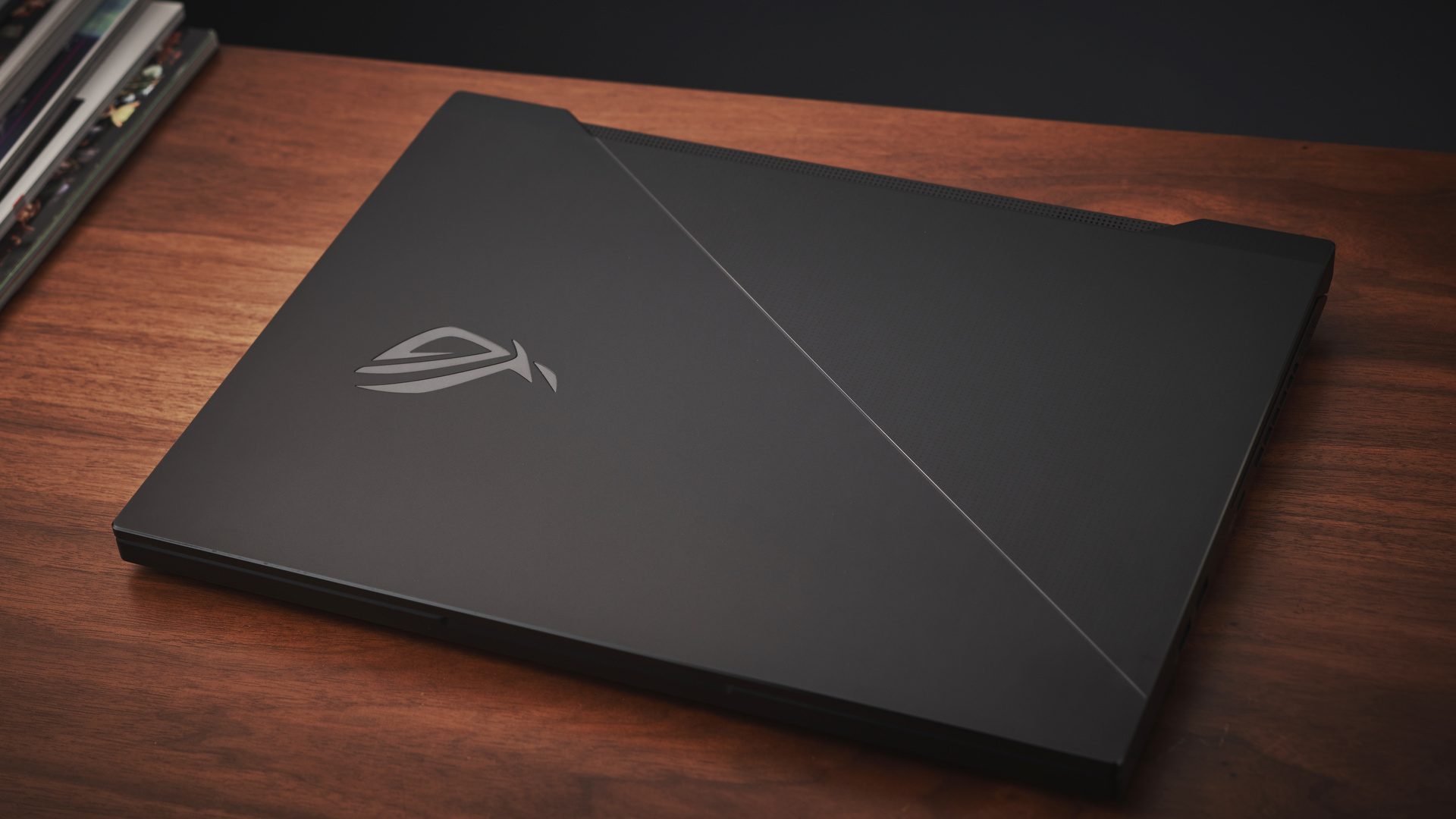
Buy it if...
You're flush with cash and really want to show off
The Asus ROG Zephyrus Duo 15 SE GX551 is a machine which will have people looking, and which will give your games the absolute best they can get from a laptop. It's something you'll treasure and enjoy.
You need the versatility of that second screen
It's of questionable usefulness for some people, but if you're streaming or using Discord it's useful as a touch-enabled way to access those secondary tools, and it could be a great help if you're using that power for creative pursuits.
You need ultimate power
Just about everyone, from gamers to artists to video producers, can benefit from the muscles on display here - there's nothing quite like the combination of RTX 3080 and Ryzen R9 5900 HX for ploughing through high-demand tasks.
Don't buy it if...
You're not likely to use that second screen
While reviewing the Asus ROG Zephyrus Duo 15 SE GX551 we found ourselves convincing ourselves that using the second screen was handy, but in the cold light of day we're a little less convinced of its utility - we wouldn't miss it if it wasn't there. It has support for certain games like Dying Light, but will Asus sell enough of these to make that support widespread? We doubt it.
You want to work or game comfortably
Man, that keyboard and trackpad combo just isn't great. We can completely understand the reason it's like it is, but it's just not nice to use, and very difficult to get used to. External peripherals beckon.
You don't have an over-average income
Like everything with an RTX 3080 at this point in time, this is simply too expensive to appeal to most people. It's a symbol of excess that probably doesn't justify that price.
- These are the best gaming laptops of 2021
